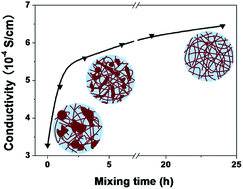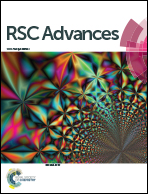Large interfacial area enhances electrical conductivity of poly(3-hexylthiophene)/insulating polymer blends†
Abstract
Semiconducting polymer/insulating polymer blends are promising materials for applications in organic optoelectronics. Here, two semiconducting polymer (SP)/insulating polymer (IP) blends, poly(3-hexylthiophene) (P3HT) and polystyrene (PS) or polyisoprene (PI), were prepared. The relationship between the electrical conductivity and the crystallinity/morphology of the P3HT/IP blends was systematically investigated. To prepare P3HT/IP blend films with different morphology, in particular the length-scale of phase separation, a P3HT/IP solution was obtained via mixing P3HT and IP solutions. The mixing homogeneity between P3HT and IP in the solution was controlled via tuning mixing time of the two solutions. The conductivity of the P3HT/IP blend film significantly increased with mixing time, as a consequence of decreased scale of phase separation between P3HT and IP. We therefore conclude that this enhanced conductivity of the blends is attributed to the large interfacial area between these two components of the blend, rather than crystallinity of P3HT, which presents a downward trend with increasing time. The relationship between the electrical properties and the interfacial area provides SP/IP blends with an important criterion both for scientific research and real application.


 Please wait while we load your content...
Please wait while we load your content...